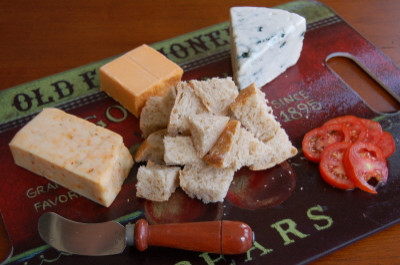The Science of Cheese, From Blue Veins To Creamy Camembert

What makes a blue cheese blue? Or a camembert so creamy? The answers to those questions offer a window into both the science and art that go into the craft of cheesemaking.
From just a few simple ingredients – milk, acids, rennet taken from the stomachs of young, slaughtered calves – cheesemakers can create a wide range of cheeses to satisfy every kind of palate. (Not all cheese is made with rennet. Click here for a list of vegetarian cheeses.)
There are three basic steps of cheesemaking: curdling the milk, draining and pressing the curds and removing the whey, followed by aging and ripening. All throughout the process, cheesemakers can employ any number of tricks to produce anything from Gouda to Limburger.
Making an especially creamy cheese like double or triple-cream camembert is all about adding fat, usually by using cream along with milk in the cheesemaking process. More moisture and water in the cheese also factors into a creamy mouthfeel. Hard cheeses tend to be drier and saltier.
“Cheesemaking is all about losing water, and I can control how much water that I lose,” says Mark Johnson, senior scientist at the University of Wisconsin’s Center for Dairy Research.
Crumbly cheeses can result from several kinds of factors. Sometimes crumbliness is the result of a very dry cheese, but then there are moister, yet still crumbly cheeses like feta or queso fresco. In these cases, Johnson says, the key is controlling the acidity of the cheese.
Acids are added to cheese at several points in the process: during the initial step of curdling the milk, when a cheesemaker can add vinegar or lemon juice, and then later, as bacteria in the cheese break down milk sugars. A cheesemaker can control the acid produced in this second step by manipulating the bacteria. Some bacteria will stop growing and consuming if salt is added; others are deactivated by cold. By controlling both saltiness and temperature, the cheesemaker can nudge the bacteria in the desired direction.
Crumbliness is found in cheeses with very low levels of acid, like queso fresco, or with lots of bacterially-produced acid, like feta, Johnson says.
Spidery blue veins of mold give blue cheeses like Stilton or Roquefort their distinct flavor. The veins usually come from the fungus Penicillium roqueforti, which is mixed in early on in the cheesemaking process. As the cheese is ripening, the cheesemaker pierces it with a stainless steel or copper poker to let oxygen in. The oxygen allows the fungus to grow, and it fills up the holes with blue veins.
Another specialty ingredient in some cheeses is ash. Many goat cheeses are coated with food-grade activated charcoal ash, which provides a counterpoint to the cheese’s acidity and also provides a habitat for certain molds that add to the flavor of the cheese.
A particular kind of cows’ milk cheese called Morbier contains a single black layer of ash in its middle. This comes from the traditional method of making Morbier, in which the bottom layer was made at the end of the day with leftover curds, spread with a protective layer of ash, and then topped off with new curds in the morning. Nowadays, the ash isn’t necessary, but most makers add it for tradition’s sake.
Feel free to share your new knowledge with your fellow turophiles over a nice cheese plate!
© Copyright IBTimes 2024. All rights reserved.





















